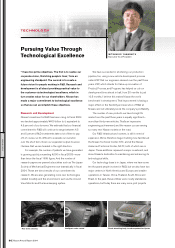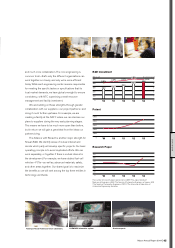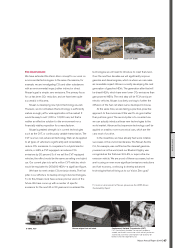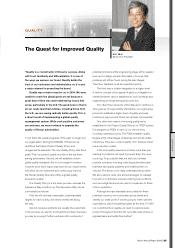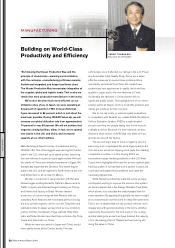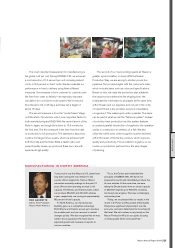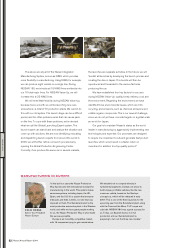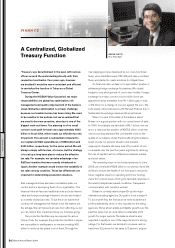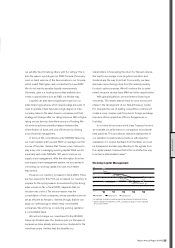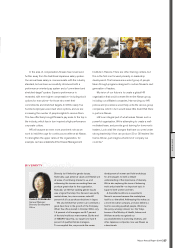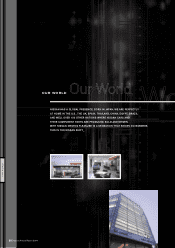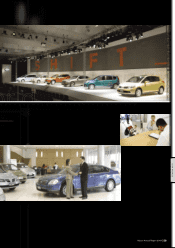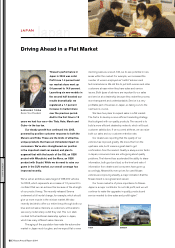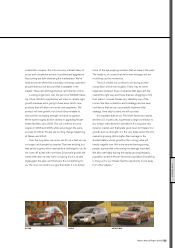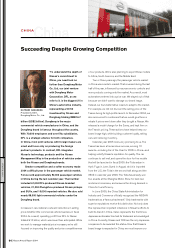Nissan 2005 Annual Report Download - page 56
Download and view the complete annual report
Please find page 56 of the 2005 Nissan annual report below. You can navigate through the pages in the report by either clicking on the pages listed below, or by using the keyword search tool below to find specific information within the annual report.
Nissan Annual Report 2004
54
risk-mapping process developed by our cross-functional
team, we’ve identified nearly 860 different risks, prioritized
them, and started to create solutions to mitigate them.
On financial risks, we take a ‘no speculation’ position in
addressing foreign exchange fluctuations. We usually
hedge for only short periods of one to two months. Foreign
exchange is a major concern, since a shift of one yen
against the dollar translates to an ¥11 billion gain or loss,
or ¥2 billion for a change of one yen against the euro. We
hold weekly videoconferences with Renault Finance S.A. in
Switzerland to exchange ideas and forecast trends.
When it comes to the state of the balance sheet,
Nissan is in a good position with our current levels of debt.
In 1998, for example, we had debt of ¥2.1 trillion; now we
are in a cash-positive position of ¥205.8 billion under the
new accounting standard. We concentrate more on the
quality of our balance sheet. Factors affecting the balance
sheet include our pension situation and possible
impairment of assets. We have sold off a number of non-
core assets over the past five years, significantly reducing
the risk of capital loss from differences between market
and book values.
The remaining issue is non-funded pensions. In June
2005, we contributed ¥228 billion to our pension fund. We
did this to ensure the health of our fund and to reduce its
future negative impact on operating profit. Our funding
came from a bond issue, which got a favorable response in
the market despite bad market conditions. Transparent
communication with investors worked.
Nissan is currently rated a triple-B+ by the major
international rating agencies. Our goal is to be a single A.
To accomplish this, the first issue we need to address is
profit sustainability, which is very important to the rating
agencies. We’ve shown stable profitability growth over the
past few years, but we must deliver sustainable profit
growth for longer periods. The balance sheet is also
important. Liquidity is one of the major factors for strong
ratings. For that reason we decided to increase cash on
hand from 3.5 percent of net sales to 8 percent, a figure
FINANCE
“Treasury was decentralized in the past, with various
offices around the world dealing directly with their
respective local banks. Four years ago, however,
we decided it would be more consistent and efficient
to centralize the function in Tokyo as a Global
Treasury Center.
During the NISSAN Value-Up period, my major
responsibilities are global tax optimization, risk
management and quality improvement of the balance
sheet. Global tax optimization is a major challenge
because our taxable income has been rising. We used
to be reactive to tax policies, but we’ve realized that
we need to be more proactive, since tax is one of the
biggest cash-out items. Tax planning is of no small
concern; cash paid for taxes was approximately ¥200
billion in fiscal 2004, which made our effective tax rate
33 percent. This amount is substantial compared to
our capital and R&D expenditures of ¥480 billion and
¥400 billion, respectively, for the same period. We will
always comply with tax law, of course, but the strategy
is to set up a long-term plan to reduce the effective
tax rate. For example, we can take advantage of an
R&D tax incentive that was recently introduced in
Japan. Another example would involve the variability in
tax rates among countries. These tax differences are
important in determining production locations.
Risk management has also been centralized under our
control, and is a developing facet of our organization. The
financial risks we face are traditional ones such as interest
rates and foreign exchange. However, we are also subject
to a variety of physical risks. To put this in an automotive
context, risk management at Nissan is not the brakes, but
the airbags. We can’t prevent all risks from affecting us, but
we can reduce their impact and keep our business going.
Our production facilities may be exposed to various
forms of risk. For example, the production facilities in Japan
are susceptible to earthquakes, so we are investing ¥20
billion to reinforce the pillars in all of them. Through the
A Centralized, Globalized
Treasury Function AKIRA SATO
Vice President
OUR WORK


